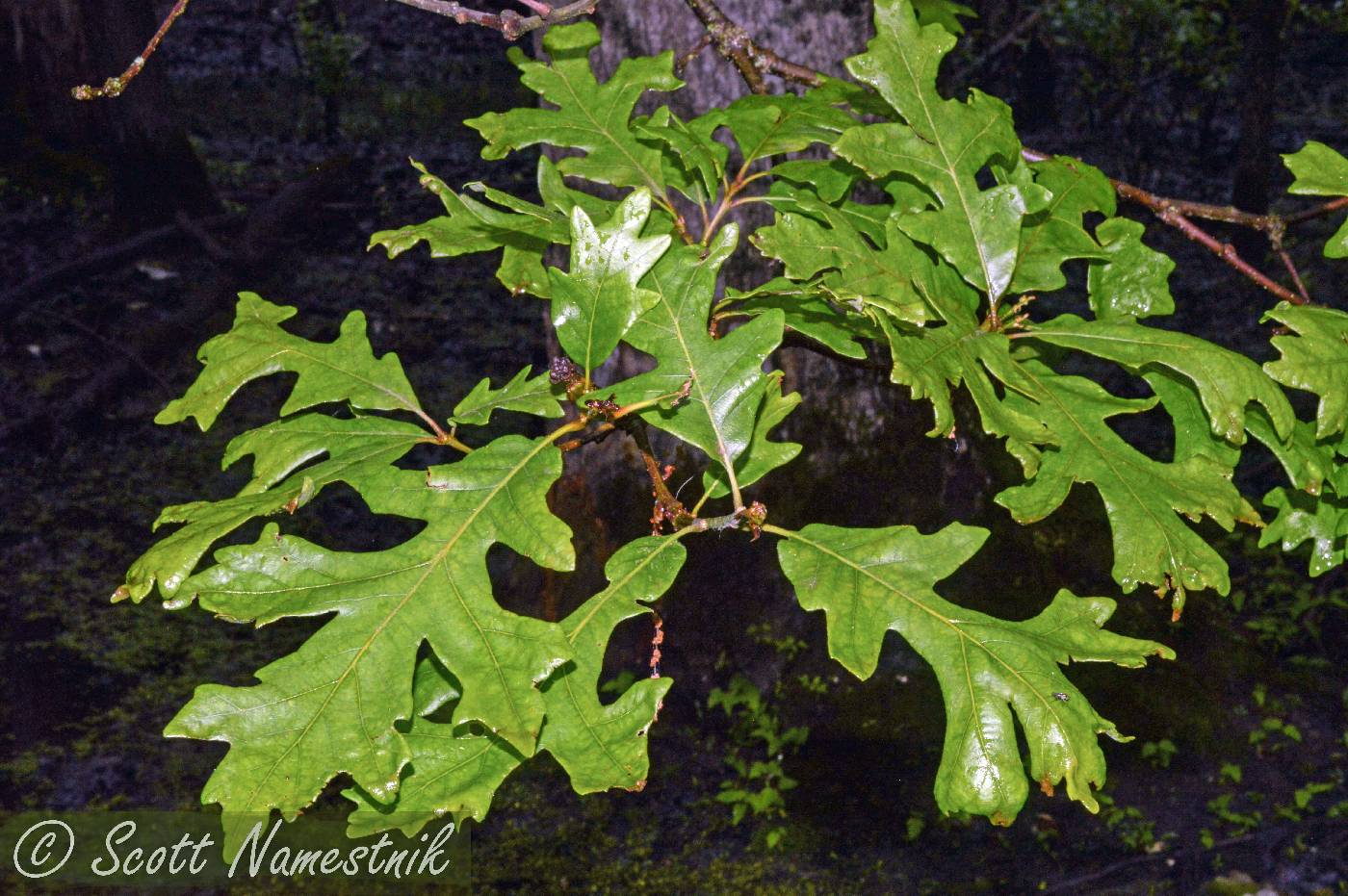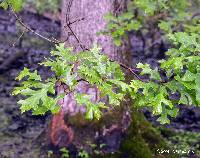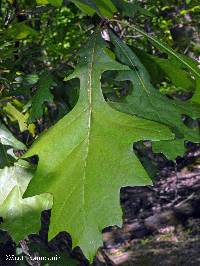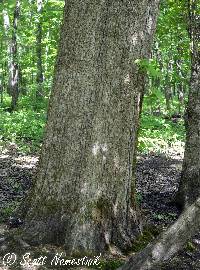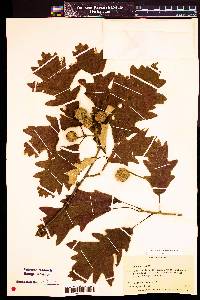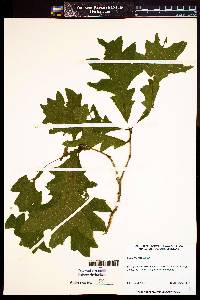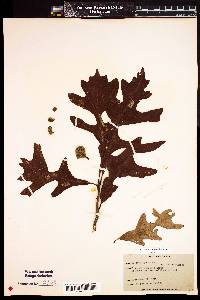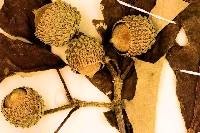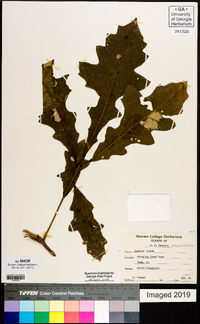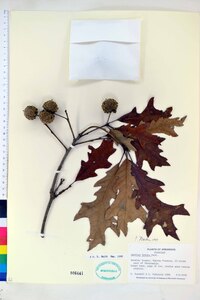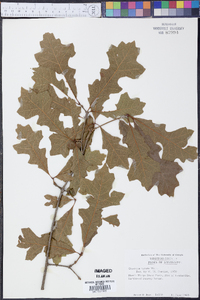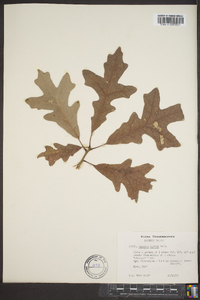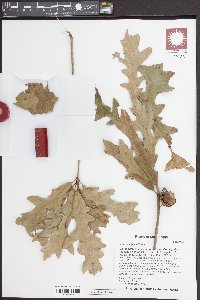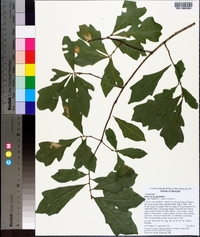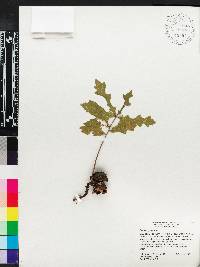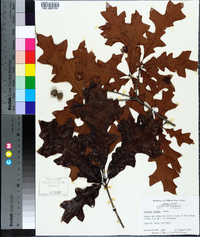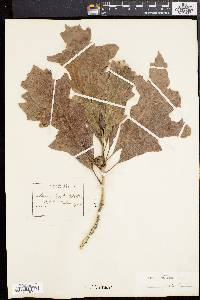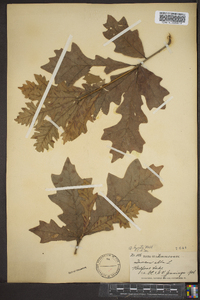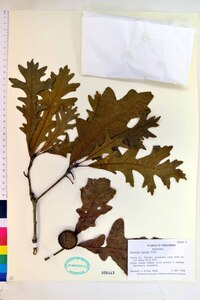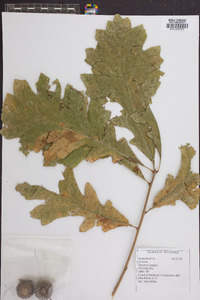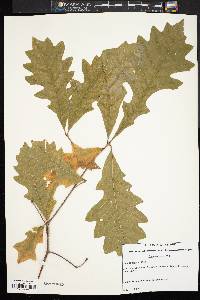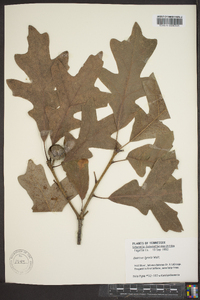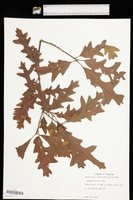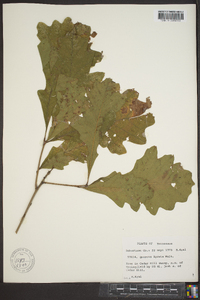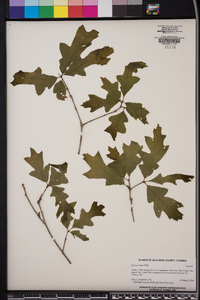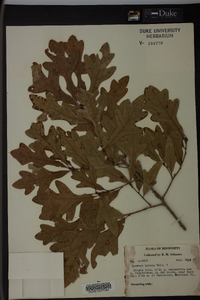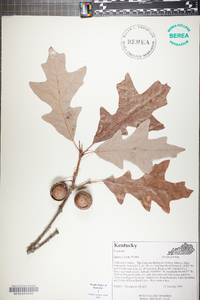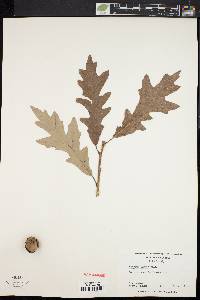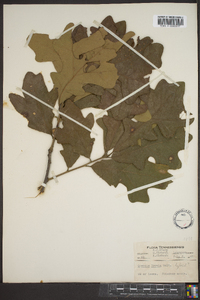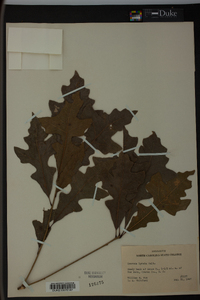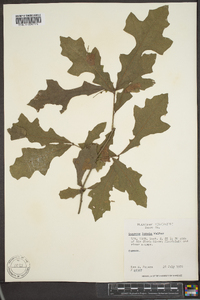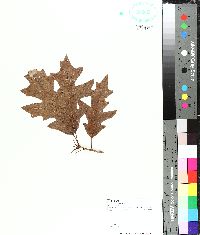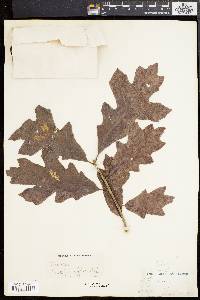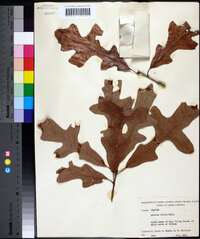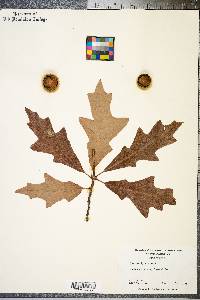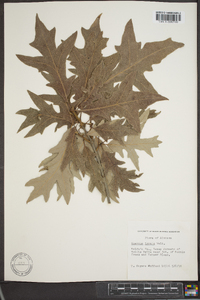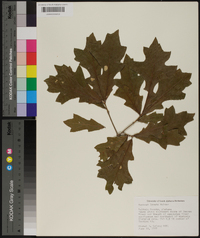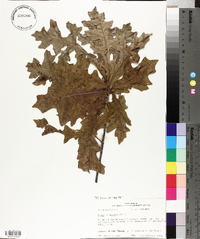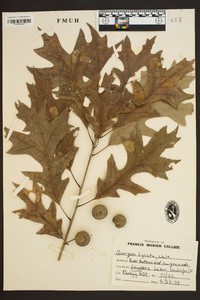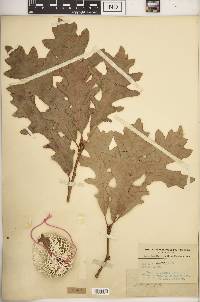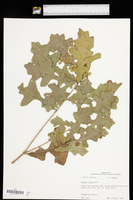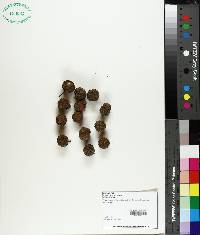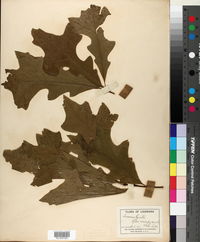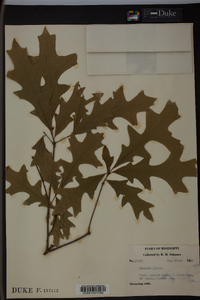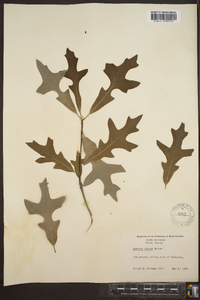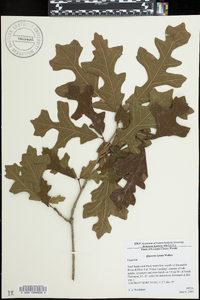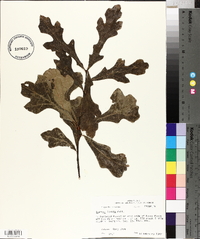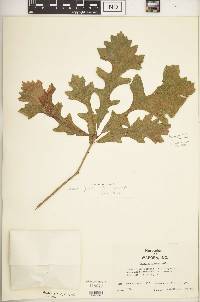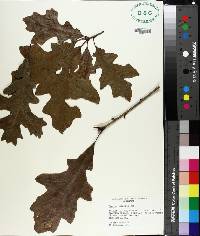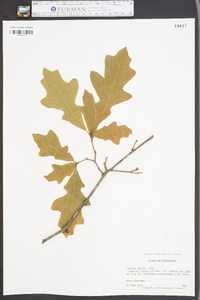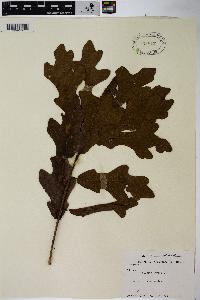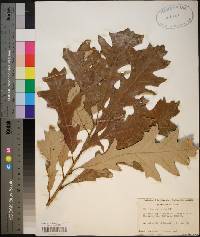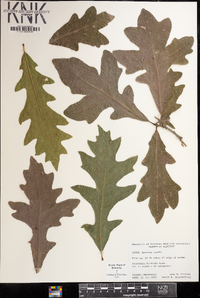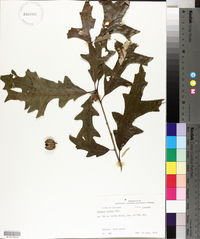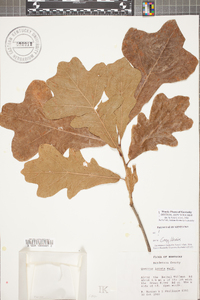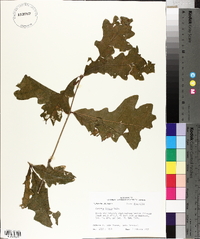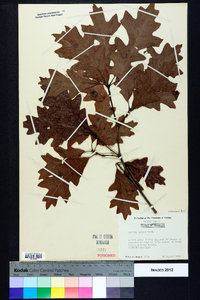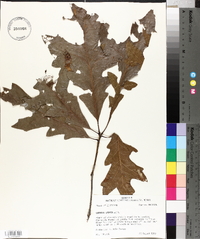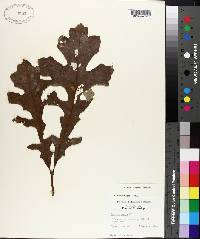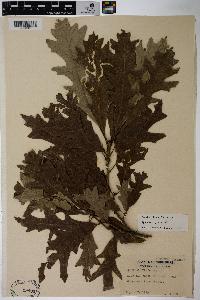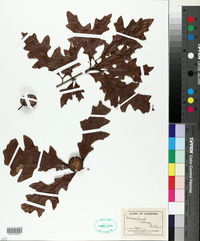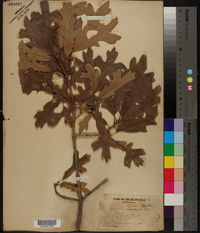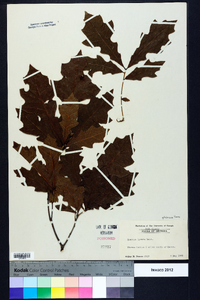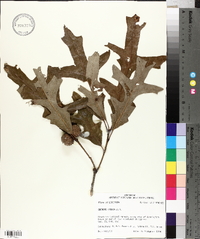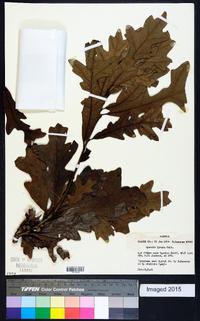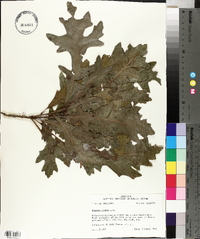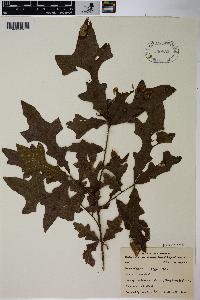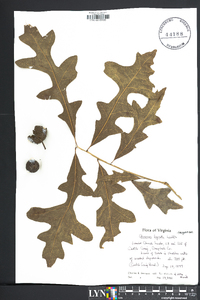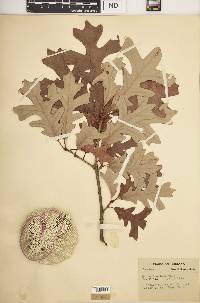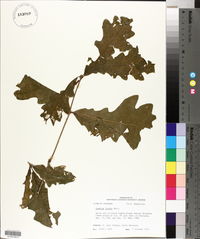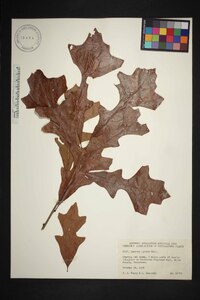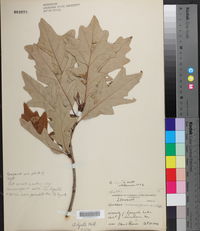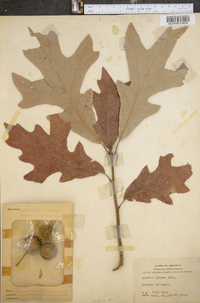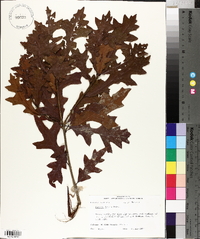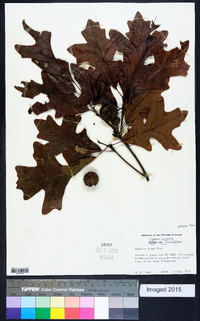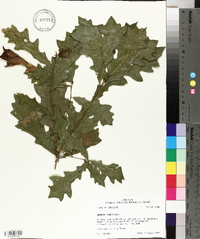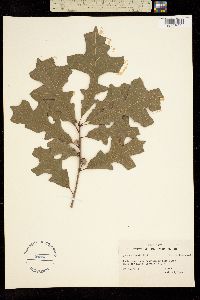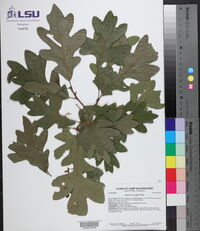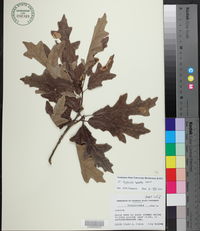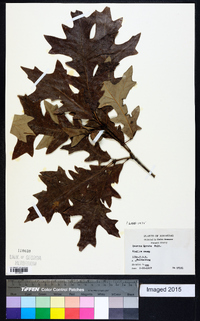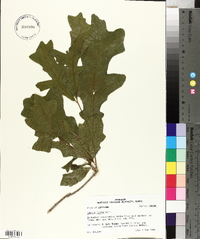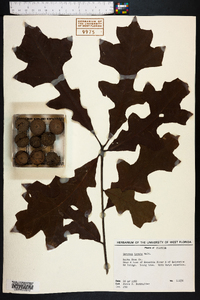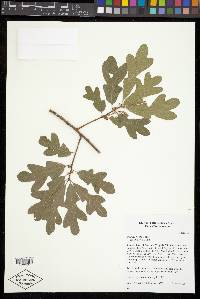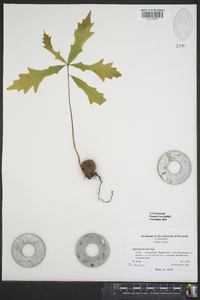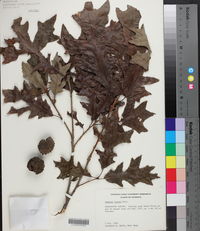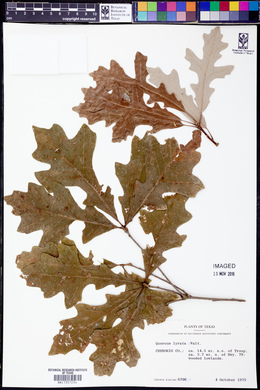
|
|
|
|
Family: Fagaceae
Overcup Oak
|
Trees , deciduous, to 20 m. Bark light gray, tinged with red, with thick plates underlying scales. Twigs grayish or reddish, (2-)3(-4) mm diam., villous, soon glabrate. Buds 3 mm, gray-puberulent. Leaves: petiole 8-20(-25) mm. Leaf blade obovate or broadly obovate, 100-160(-200) × 50-100(-120) mm, base narrowly cuneate to acute, margins moderately to deeply lobed, lobes somewhat to sharply angular or spatulate, often with 2-3 teeth, sinuses nearly to midrib, secondary veins arched, divergent, (3-)5-7 on each side, apex broadly rounded or ovate; surfaces abaxially light green or somewhat glaucous, tomentose, tomentum persisting or soon falling, adaxially dark green or dull gray, sparsely puberulent to glabrate. Acorns 1-2 on axillary peduncles to 40 mm; cup goblet-shaped, burlike, or spheroid, 15-20 mm deep × 20-30 mm wide, usually completely enclosing nut or merely apex visible, rarely enclosing only 1/2 nut, orifice smaller than nut diameter, often splitting irregularly at maturity, scales closely appressed, especially about margin, laterally connate, broadly triangular, keeled-tuberculate, finely grayish tomentose; nut light brown or grayish, ovoid-ellipsoid or oblong, (15-)25-50 × (10-)20-40 mm, finely puberulent or floccose. Cotyledons distinct. Flowering spring. Bottoms, lowlands, wet forest, streamside forests, swamp forests, periodically inundated areas; 0-200 m; Ala., Ark., Del., Fla., Ga., Ill., Ind., Iowa, Ky., La., Md., Miss., Mo., N.J., N.C., Okla., S.C., Tenn., Tex., Va. The large acorns with hardened cups that enclose all or most of the nut are diagnostic.
Tree 20 - 30 m tall, trunk to 1 m in diameter Leaves: alternate, short-stalked, dark green above, paler green to grayish with sparse hairs beneath, 16 - 25 cm long, 2.5 - 10 cm wide, inversely egg-shaped, with three to five pairs of shallowly to deeply rounded lobes. Leaves turn yellow, orange, or red in fall. Flowers: either male or female, found on the same tree (monoecious), yellow male flowers borne on hanging catkins 10 - 15 cm long, small female flowers borne in few-flowered clusters near leaf axils. Fruit: an acorn, maturing in one season, solitary or in pairs, with a 0 - 2.5 cm long stalk. The fringed cup almost surrounds the rounded nut and has thick scales with grayish hairs. Bark: reddish brown to grayish brown, fissured into flattened plates. Twigs: green and hairy when young, becoming reddish brown to grayish brown and smooth. Buds: light brown to grayish, 2 - 4 mm long. Each terminal bud is surrounded by a cluster of lateral buds. Form: pyramidal, becoming rounded. Similar species: Many oaks in the white oak group and Quercus robur have highly variable, similar leaves with rounded lobes. Quercus alba often has deeply lobed leaves, light gray bark usually with smooth patches, and an acorn cup covered with warty scales. Quercus bicolor has round-toothed to shallowly lobed leaves that are whitish and hairy beneath, peeling bark on young branches, and a long-stalked acorn cup. Quercus macrocarpa has deeply lobed leaves that are inversely egg-shaped and hairy beneath, often corky-ridged twigs, and an acorn cup with long fringes along the margin. Quercus robur has very short-stalked leaves with ear-like lobes at the base, and a long-stalked acorn cup. Flowering: March to April Habitat and ecology: Bottomlands, river swamps, sloughs, floodplains and wet forests. Occurence in the Chicago region: non-native Notes: Quercus lyrata has very strong wood that is used as lumber. However, its many knots make it inferior to Q. alba wood. Etymology: Quercus is the Latin word for oak. Lyrata means "shaped like a lyre." Author: The Morton Arboretum Tree to 30 m, with thick, gray bark, the twigs soon glabrescent; lvs narrowly obovate, densely gray-tomentose beneath with horizontally spreading, many-branched stellate hairs, above which project a few erect, few-branched hairs, or with only the latter type of hair; lateral lf- lobes 2-4 pairs, oval, rounded to subacute, rarely emarginate, the lower usually much smaller and separated from the upper by often elongate sinuses; acorns 1.5-2.5 cm, about as thick; cup covering half to all the conic-ovoid nut, the lower scales strongly concave. Wet woods and swamps on the coastal plain; s. N.J. to Fla. and Tex., n. in the interior to s. Ind., s. and w. Ill., and Mo. Gleason, Henry A. & Cronquist, Arthur J. 1991. Manual of vascular plants of northeastern United States and adjacent Canada. lxxv + 910 pp. ©The New York Botanical Garden. All rights reserved. Used by permission. From Flora of Indiana (1940) by Charles C. Deam This species is very local in the southwestern counties where it grows about river sloughs and in swamps and low, wet woods. Its habitat is usually inundated each year. I have not seen it common except in a low woods along Prairie Creek about 5 miles northwest of Montgomery in Daviess County. Here it is associated with the swamp chestnut oak. In 1931, on the bank of Slim Pond (an old river channel) in Posey County, I measured a specimen that was 56 inches in diameter at breast height, and had a clear bole of about 12 feet. Clapp writes he saw it in the vicinity of New Albany. …… Indiana Coefficient of Conservatism: C = 7 Wetland Indicator Status: OBL Deam (1932): Wood and uses similar to those of white oak. In our area it is usually known as bur oak. |

